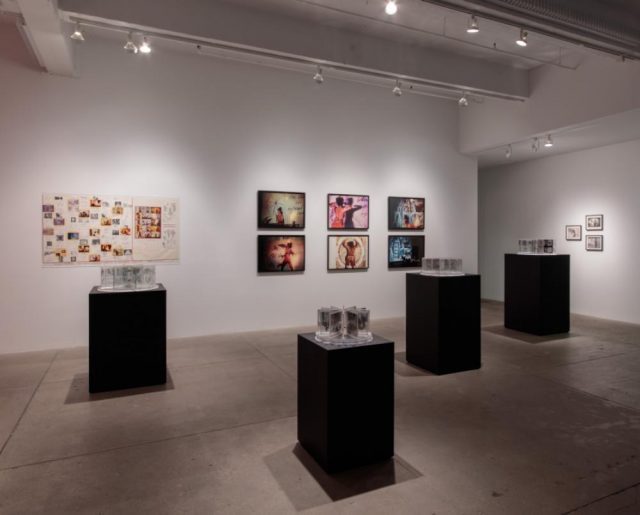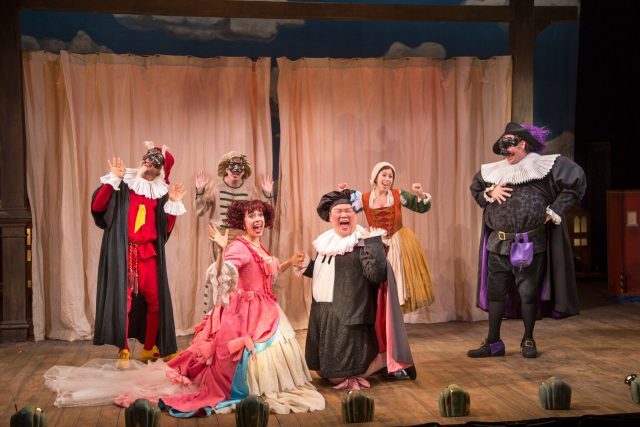
Clarice (Adina Verson) and Silvio’s (Eugene Ma) true love is threatened in THE SERVANT OF TWO MASTERS (photo by Henry Grossman)
Theatre for a New Audience, Polonsky Shakespeare Center
262 Ashland Pl. between Lafayette Ave. & Fulton St.
Tuesday – Sunday through December 4, $85
866-811-4111
www.tfana.org
“For nitwits are we all,” the cast declares early on in Theatre for a New Audience’s wacky version of Carlo Goldoni’s eighteenth-century commedia dell’arte classic, The Servant of Two Masters, only the second time the show has ever been presented in English in New York City. The strange and crazy antics, involving lots of nitwits and numbskulls, take place over one very long day in Venezia, as the masked Truffaldino Batocchio from Bergamo (Steven Epp) serves up chaos while secretly serving two masters. The very hungry Truffaldino’s predicament derives from a typically byzantine plot: the supposed death of Federigo Rasponi from Torino is followed by the appearance of Federigo’s sister, Beatrice (Liz Wisan) — disguised as her brother in order to marry his betrothed, Clarice (Adina Verson), the daughter of his business partner, Pantalone (Allen Gilmore), and collect a promised dowry. Truffaldino immediately signs on to serve Federigo/Beatrice. Meanwhile, Clarice wants to marry her true love, Silvio (Eugene Ma), the pampered and overly twee progeny of Dr. Lombardi (Andy Grotelueschen). Later, when the valiant Florindo Aretusi (Orlando Pabotoy) shows up, Truffaldino accepts a position with him as well after Florindo’s aging porter (Liam Craig) proves inadequate. But even though Florindo and Beatrice are madly in love, neither knows the other is in town, and Truffaldino, who has become smitten with Smeraldina (Emily Young), Clarice’s maidservant, struggles to keep it that way so they won’t discover that he’s serving both of them. Over the course of two and a half hours (with intermission), there is masked mayhem, mistaken identity, slapstick comedy, devious deception, satirical songs (with onstage music by Christopher Curtis and Aaron Halva), and improvisation galore, some that works, and some that doesn’t.
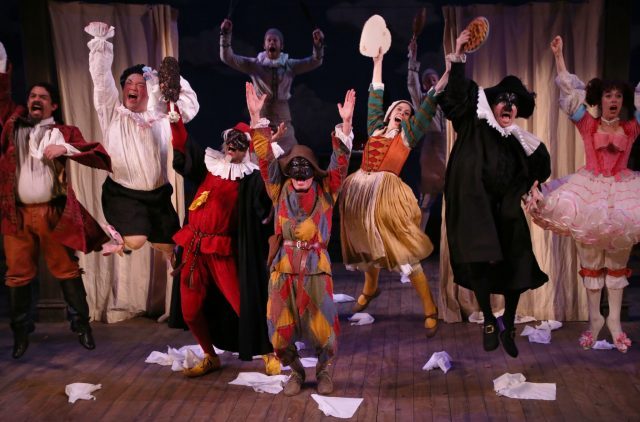
The cast of THE SERVANT OF TWO MASTERS has a blast in commedia dell’arte classic (photo by Gerry Goodstein)
In 2011, playwright Richard Bean and director Nicholas Hytner transformed The Servant of Two Masters into the hit Broadway comedy One Man, Two Guvnors, which earned James Corden a Tony for Best Actor. At TFANA’s Polonsky Shakespeare Center, director Christopher Bayes (This Ridiculous Dreaming, The 39 Steps) and star Epp (Tartuffe, Figaro), veterans of Theatre de la Jeune Lune, have gone back to Goldoni’s more improvisational original, further adapting Constance Congdon’s version of Christina Sibul’s translation, eschewing a more structured narrative for large amounts of ad libbing. Thus, the play is different every night; right now it is rife with references to the presidential election that can range from wickedly funny to random and repetitive, along with nods to current commercial jingles that get chuckles but feel out of place. Valérie Thérèse Bart’s period costumes are a hoot, colorful and dankly elegant, while Katherine Akiko Day’s set is centered by a curtain through which the characters enter and exit, with a trompe l’oeil sky in the background in front of which are miniature houses. The cast, many of whom have worked together before either at Yale Rep or Juilliard, displays an infectious camaraderie and a willingness to try just about anything; Epp is a terrific physical comedian, harkening back to the days of vaudeville, while Pabotoy, Gilmore, and Fiasco Theater’s Grotelueschen and Young are stand-out commedia dell’arte practitioners. The play is probably about a half hour too long, and the anti-Trump jokes were often too easy and obvious, detracting from the overall atmosphere of chaotic fun. In the beginning, Truffaldino asks several times, “When’s the play going to start?” Near the conclusion, he declares, “This play’s never gonna end!” Of course, it does end, and you’ll leave the theater in a gleeful mood, if not completely satiated.
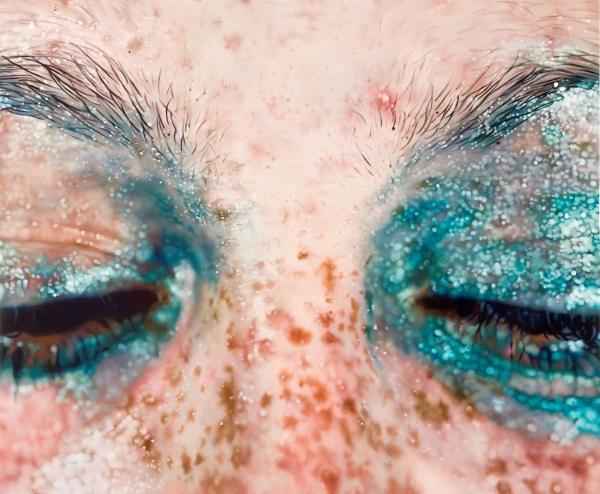
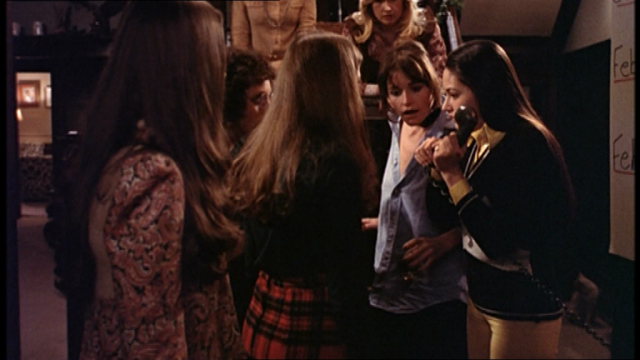
 American-Canadian filmmaker Bob Clark might be best known for the holiday favorite A Christmas Story, but he also directed another, very different yuletide cult classic, Black Christmas. Clark, who had previously made Children Shouldn’t Play with Dead Things and would go on to make such wide-ranging fare as Rhinestone, Turk 182!, Porky’s, and Baby Geniuses, assembled quite a cast for the 1974 horror flick, also known as Silent Night, Evil Night: Olivia Hussey (Romeo and Juliet), Keir Dullea (2001: A Space Odyssey, Bunny Lake Is Missing), Margot Kidder (Sisters, Superman), John Saxon (Enter the Dragon, A Nightmare on Elm Street), Art Hindle (The Brood, Invasion of the Body Snatchers), and Andrea Martin (SCTV, Pippin). The story is set in a sorority house run by Mrs. MacHenry (Marian Waldman), who lets the young women pretty much do whatever they want (while regularly sneaking drinks herself). A series of obscene phone calls has some of the sisters on edge while Barb (Kidder) is much more bold, challenging the twisted voice. After Clare (Lynne Griffin) disappears, the other women start growing more concerned, including Phyllis (Martin) and Jess (Hussey), as do Phyllis’s boyfriend, Patrick (Michael Rapport), Clare’s boyfriend, Chris (Hindle), and Olivia’s lover, Peter (Dullea), along with Clare’s prim and proper father (James Edmond) and local police lieutenant Kenneth Fuller (Saxon). With Christmas approaching, the body count starts piling up, as do the genre clichés, but it’s all in good fun.
American-Canadian filmmaker Bob Clark might be best known for the holiday favorite A Christmas Story, but he also directed another, very different yuletide cult classic, Black Christmas. Clark, who had previously made Children Shouldn’t Play with Dead Things and would go on to make such wide-ranging fare as Rhinestone, Turk 182!, Porky’s, and Baby Geniuses, assembled quite a cast for the 1974 horror flick, also known as Silent Night, Evil Night: Olivia Hussey (Romeo and Juliet), Keir Dullea (2001: A Space Odyssey, Bunny Lake Is Missing), Margot Kidder (Sisters, Superman), John Saxon (Enter the Dragon, A Nightmare on Elm Street), Art Hindle (The Brood, Invasion of the Body Snatchers), and Andrea Martin (SCTV, Pippin). The story is set in a sorority house run by Mrs. MacHenry (Marian Waldman), who lets the young women pretty much do whatever they want (while regularly sneaking drinks herself). A series of obscene phone calls has some of the sisters on edge while Barb (Kidder) is much more bold, challenging the twisted voice. After Clare (Lynne Griffin) disappears, the other women start growing more concerned, including Phyllis (Martin) and Jess (Hussey), as do Phyllis’s boyfriend, Patrick (Michael Rapport), Clare’s boyfriend, Chris (Hindle), and Olivia’s lover, Peter (Dullea), along with Clare’s prim and proper father (James Edmond) and local police lieutenant Kenneth Fuller (Saxon). With Christmas approaching, the body count starts piling up, as do the genre clichés, but it’s all in good fun.
 In honor of World AIDS Day, Nitehawk Cinema is teaming up with
In honor of World AIDS Day, Nitehawk Cinema is teaming up with 
